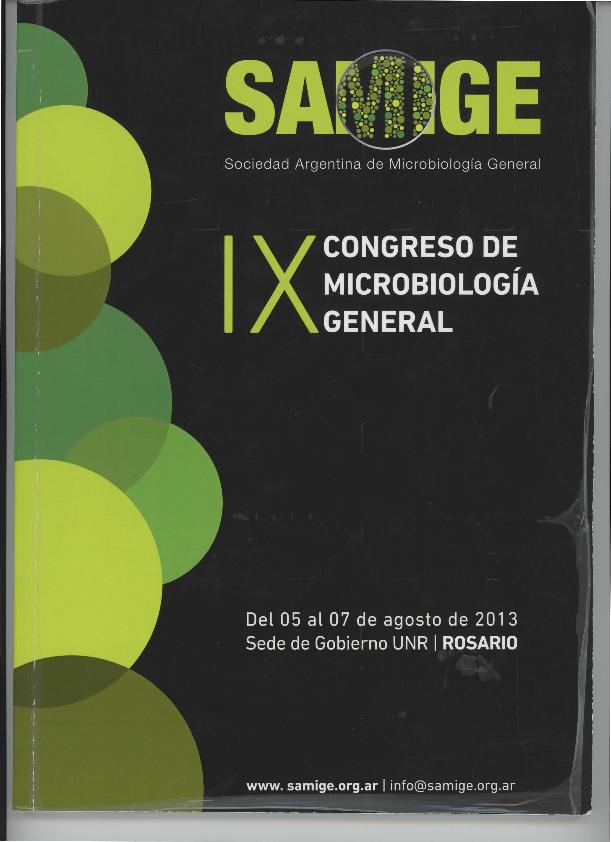Mostrar el registro sencillo del ítem
dc.contributor.author
Abdulhamid, María Belén

dc.contributor.author
Costas, Luciana

dc.contributor.author
Baigori, Mario Domingo

dc.contributor.author
Pera, Licia Maria

dc.date.available
2023-03-13T13:32:26Z
dc.date.issued
2013
dc.identifier.citation
Hydrolytic activity of microbial lipase aggregates induced by heat treatment; IX Congreso de Microbiología General; Rosario; Argentina; 2013; 1-3
dc.identifier.uri
http://hdl.handle.net/11336/190305
dc.description.abstract
Lipases (EC 3.1.1.3) are enzymes characterized by the ability to catalyze the hydrolysis of triglycerides at the interface between the insoluble substrate and water. Currently, lipases are a popular choice as a biocatalyst because they can be applied to chemo-, regio- and enantioselective hydrolyses and also in the syntheses of a broad range of compounds. These enzymes are considered to have great potential in numerous industrial processes, such as the synthesis of food ingredients, their use as additives to detergents and to obtain enantiopure drugs and other refined products. In addition, enzyme aggregates have emerged as an interesting biocatalyst design for immobilization. Generally, they can be produced by different protein precipitation techniques such as the addition of a salt or an organic solvent. In this work, the effect of lipase aggregation induced by heat treatment on its hydrolytic activity was evaluated. Sixty-four spore-forming microorganisms isolated from different oil contaminated soil samples were used. The most promising microorganisms were molecularly identified by using 16S partial rDNA sequencing. The extracellular lipase production was carried out by submerged fermentation in the Luria-Bertani (LB) medium. Hydrolytic activity of either supernatant or dried sample was measured using p-NPP (p-nitrophenyl palmitate; C16) as substrate. Cleavage of pNPP was performed at 37 °C in 100 mM phosphate buffer (pH 7.0) containing 0.1% (w/v) Arabic gum and 0.4% (w/v) Triton X-100 .The molar extinction coefficient of p-nitrophenol (p-NP) under the given assay conditions was 0.0103 μM−1cm−1. Dried supernatant was obtained by using a speed vacuum system (Savant Instruments, Inc) for 3 h at 45 ˚C. One unit of enzyme activity was defined as the amount of biocatalyst that released 1 µmol of p-NP per min. In general, it was found that the lipase aggregates induced by heat treatment showed higher hydrolytic activity than that the corresponding liquid supernatant. As an example, the hydrolytic activity of heat treated lipases from Brevibacillus brevis 47M, B. agri 49M, B. agri 52M and B. agri E12 was increased by 24.6, 454.8, 314.9 and 10.5 %, respectively. To conclude, the hydrolytic activity of lipase aggregates from different spore-forming microorganisms has been presented showing an interesting biotechnological and industrial relevance.
dc.format
application/pdf
dc.language.iso
eng
dc.publisher
Sociedad Argentina de Microbiología General
dc.rights
info:eu-repo/semantics/openAccess
dc.rights.uri
https://creativecommons.org/licenses/by-nc-sa/2.5/ar/
dc.subject
SPORE FORMING MICROORGANISMS
dc.subject
LIPASE AGGREGATES
dc.subject
HYDROLYTIC ACTIVITY
dc.subject.classification
Bioprocesamiento Tecnológico, Biocatálisis, Fermentación

dc.subject.classification
Biotecnología Industrial

dc.subject.classification
INGENIERÍAS Y TECNOLOGÍAS

dc.title
Hydrolytic activity of microbial lipase aggregates induced by heat treatment
dc.type
info:eu-repo/semantics/publishedVersion
dc.type
info:eu-repo/semantics/conferenceObject
dc.type
info:ar-repo/semantics/documento de conferencia
dc.date.updated
2023-03-08T14:57:32Z
dc.journal.pagination
1-3
dc.journal.pais
Argentina

dc.journal.ciudad
Rosario
dc.description.fil
Fil: Abdulhamid, María Belén. Consejo Nacional de Investigaciones Científicas y Técnicas. Centro Científico Tecnológico Conicet - Tucumán. Planta Piloto de Procesos Industriales Microbiológicos; Argentina
dc.description.fil
Fil: Costas, Luciana. Consejo Nacional de Investigaciones Científicas y Técnicas. Centro Científico Tecnológico Conicet - Tucumán. Instituto Superior de Investigaciones Biológicas. Universidad Nacional de Tucumán. Instituto Superior de Investigaciones Biológicas; Argentina
dc.description.fil
Fil: Baigori, Mario Domingo. Consejo Nacional de Investigaciones Científicas y Técnicas. Centro Científico Tecnológico Conicet - Tucumán. Planta Piloto de Procesos Industriales Microbiológicos; Argentina
dc.description.fil
Fil: Pera, Licia Maria. Consejo Nacional de Investigaciones Científicas y Técnicas. Centro Científico Tecnológico Conicet - Tucumán. Instituto Superior de Investigaciones Biológicas. Universidad Nacional de Tucumán. Instituto Superior de Investigaciones Biológicas; Argentina
dc.relation.alternativeid
info:eu-repo/semantics/altIdentifier/url/https://samige.org.ar/wp-content/uploads/2022/10/Libro-samige-2013.pdf
dc.conicet.rol
Autor

dc.conicet.rol
Autor

dc.conicet.rol
Autor

dc.conicet.rol
Autor

dc.coverage
Internacional
dc.type.subtype
Congreso
dc.description.nombreEvento
IX Congreso de Microbiología General
dc.date.evento
2013-08-05
dc.description.ciudadEvento
Rosario
dc.description.paisEvento
Argentina

dc.type.publicacion
Book
dc.description.institucionOrganizadora
Sociedad Argentina de Microbiología General
dc.source.libro
IX Congreso de Microbiología General
dc.date.eventoHasta
2013-08-07
dc.type
Congreso
Archivos asociados
